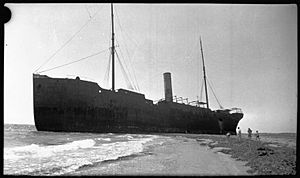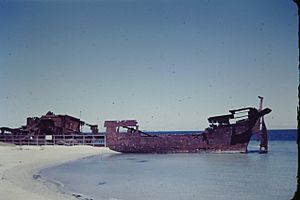SS Kwinana facts for kids

Kwinana on what is now Kwinana Beach, Western Australia
|
|
Quick facts for kids History |
|
|---|---|
| Name |
|
| Namesake |
|
| Owner |
|
| Port of registry |
|
| Route |
|
| Builder | William Doxford & Sons, Sunderland |
| Launched | 24 September 1892 |
| Completed | November 1892 |
| Identification | UK official number 101707 |
| Fate | Damaged by fire 1920–21, ran aground 1922 |
| General characteristics | |
| Tonnage |
|
| Length | 345 ft (105 m) |
| Beam | 43 ft (13 m) |
| Draught | 22 ft (6.71 m) |
| Depth | 25 ft (7.6 m) |
| Installed power | 361 NHP |
| Propulsion | 3-cylinder triple-expansion steam engine |
| Sail plan | schooner rig |
| Speed | 10 knots (19 km/h) |
| Capacity | 24 passengers (from 1912) |
The SS Kwinana was an Australian steamship that carried both cargo and passengers. She was built in England in 1892. At first, she was a cargo ship named SS Darius. In 1912, new owners bought her. They changed her into a ship that could carry people and goods. She was then renamed Kwinana.
In 1920 and 1921, a fire damaged her cargo. Then, in 1922, she was wrecked. She drifted ashore about 15 miles (24 km) south of Fremantle, Western Australia. The place where she ended up is now called Kwinana Beach. Her remains are now protected by Australian law.
Contents
The Ship's Early Life as Darius
The ship was built in 1892 by William Doxford & Sons. This company was located in Sunderland, England. She was made for Archibald Currie & Co, also known as "Currie Line." This company was based in Melbourne, Australia.
Darius was a special ship. She had sails like a schooner, but also a powerful steam engine. This engine had three cylinders and gave her a speed of 10 knots (19 km/h).
The ship was named Darius after Darius the Great. He was a famous king from ancient Persia. Inside the ship, there was a piece of frosted glass. It showed King Darius sitting on his throne. The Currie Line used Darius for trading between countries. She often carried horses and other goods between Australia and Calcutta.
Kwinana: A New Name and Role
The State Shipping Service of Western Australia (SSS) bought Darius in 1912. They paid £19,000 for her. The SSS then added a special passenger area in the back of the ship. On July 15, she was officially renamed Kwinana. This happened at a ceremony in Fremantle.
The name Kwinana comes from an Aboriginal language. It means "young woman" or "pretty maid." This name comes from the Kimberley region.
Kwinana then started carrying livestock and passengers. She sailed along the north-west coast of Western Australia. On one trip, she brought about 750 cattle from Kimberley. Because this trade was seasonal, she also traveled to other countries. She went to New Zealand, South Africa, Singapore, and Hong Kong.
Troubles at Sea
Kwinana had several problems while working for the SSS.
- In 1914, coal in her No. 2 cargo hold caught fire.
- Later in 1914, she hit a rock in Cambridge Gulf. This damaged the metal plates under her engine room.
- In 1917, her machinery was damaged near Broome.
- In 1918, her steering gear broke in Cambridge Gulf, causing her to run aground.
- In 1920, a leak started in her No. 1 cargo hold while she was loading at Christmas Island.
- In December 1920, a boiler on her right side started leaking in Fremantle.
The Big Fire of 1920
On Christmas Day in 1920, a fire started on Kwinana. She was sailing between Geraldton and Shark Bay. The ship was carrying timber and other goods to Wyndham, Western Australia. Her crew found the fire in a coal storage area. They fought the fire and thought they had put it out.
But when she reached Denham, Western Australia, the fire started again. So, Kwinana continued to Carnarvon, Western Australia. She arrived there on December 27 and got help from shore. The cargo was unloaded in Carnarvon. However, there were only small hand pumps to fight the fire. It spread to other parts of the ship. The fire was not completely put out until January 5, 1921.
A special salvage tug boat, Wyola, was sent from Fremantle. It helped put out the fire by flooding Kwinana. This made the ship sink at the Carnarvon jetty in about 19 feet of water. After the fire was out, the water was pumped out, and the ship was raised.
Returning to Fremantle
Experts checked Kwinana and said she could sail back to Fremantle. But the crew did not trust the ship's condition. They asked for extra pay to sail her. The SSS tried to make the crew work, but a court got another expert to check the ship. This expert said the ship was not safe to sail. So, the court sided with the crew.
The SSS then sent the crew back to Fremantle on another ship. A new crew was brought in to sail Kwinana. On March 25, Kwinana left Carnarvon under her own power. Another ship, Kurnalpi, sailed with her. On March 28, she reached Fremantle. But she accidentally crashed into another ship, Port Stephens.
At the bottom of Kwinana's cargo holds, there were about 1,200 tons of phosphate ore. This ore had been used as a soft bed for cattle. The ore was unloaded in Fremantle and sent to a factory.
The End of Kwinana
Kwinana was 28 years old and still had her original boilers. Her running costs were getting higher. Before the fire, the SSS thought she would only be used for a few more years. After the fire, the ship's insurers paid the owners for the damage. The SSS then tried to sell the ship, but no one wanted to buy her.
So, the SSS decided to take her apart for scrap metal. She was docked at North Wharf for several months. Workers removed all the parts that had survived the fire. However, it became too expensive to keep taking the ship apart. The cost of the work was more than the value of the scrap metal. The SSS tried to sell her again, but still no one made an offer.
The Wreck of Kwinana
On December 9, 1921, the empty ship, now a hulk, was towed to Careening Bay. This bay is near Garden Island, Western Australia. But on July 28, 1922, a big storm hit. Kwinana broke free from her ropes. The wind blew her across Cockburn Sound, and she ran aground. She landed about 3 miles (5 km) north of Rockingham.
The Royal Australian Navy told the SSS to remove the wreck. So, the SSS offered to sell her right where she was. A group of people, led by Owen Carlon, bought her.
Even after being sold, much of the wreck stayed on the beach. In 1941, parts of it were blown up. But her remains were still there and could be seen for many years. In 1959, the Fremantle Harbour Trust cut the wreck down to the water level.
The wreck became a small tourist attraction. The local postmistress, Clara Wells, started marking her mailbags "Kwinana Wreck." The area soon became known as "Kwinana Beach." In 1937, Kwinana became the official name for the town. By the 1960s, the wreck was much smaller but still easy to recognize. Since then, it has been filled with concrete. This forms a platform along the shore that people use for angling (fishing). Parts of her hull can still be seen, and her shape is still clear from the air.
Images for kids
-
Kwinana's wreck on Kwinana Beach about 1960




